ANNUAL REPORT






An innovative, prosperous heavy vehicle industry supporting the safest, most productive fleet.









With COVID-19 in the rearview mirror, I’m sure all members were eagerly hoping for a return to ‘business as usual’ without the daily struggles of running a business during a pandemic. This has largely occurred, but for the ongoing supply chain issues, skills shortages, regulatory challenges, and a new and ever-present danger of an overheating economy, powered by out-of-control inflation.
The blunt tool of 12 interest rate rises since May 2022 has seen the official cash rate move from a historic low of 0.10 per cent to 4.10 per cent in 15 months to reduce spending in the economy. For most of this time, truck, and trailer orders have continued to buck the trend, but as I write this column, it would appear we are seeing the start of a correction, as business confidence feels the pinch.
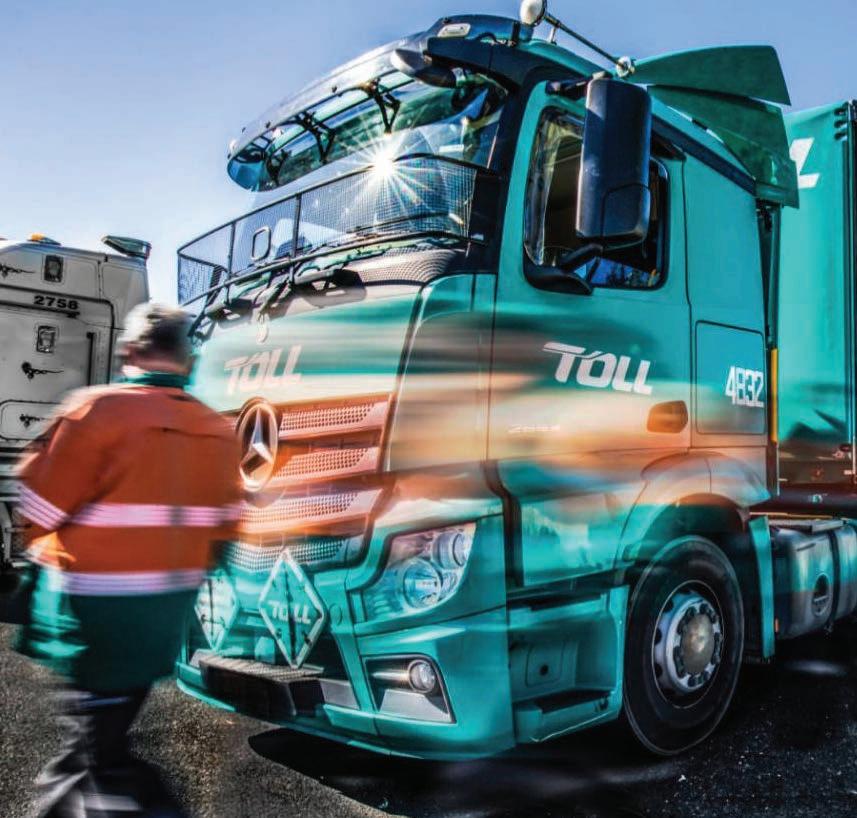
The NAB Monthly Business Survey’s business confidence index started the year on a high, with a rating of +6 (January), but then saw business confidence languish ever since with recorded figures of -4 (February), -1 (March), +1 (April), -3 (May), and zero in June.

How deep and long this correction will be is the question on OEM lips and was partly the reason behind HVIA inviting well-known economist and financial expert Michael Pascoe to address HVIA members back in March at the Executive Club held on the Sunshine Coast.
The Executive Club is a great forum for networking and participating in information exchange relevant to the industry. Our August forum in Sydney addressed the topic of ‘Net Zero, Climate Risk, and ESG: What Does It All Mean?’ And in Melbourne in October, we will hear from Kim Lindsay, former Chief Executive of Lindsay Australia, providing insights on the future of the heavy vehicle transport industry, from the perspective of one of the largest ASX-listed transport companies in Australia.
Despite the wider economic pessimism, I think all members who exhibited or attended the 2023 Brisbane Truck Show will attest to a general view of optimism, as the largest-ever crowd of 42,855 people flowed through the doors of the Brisbane

Convention and Exhibition Centre in May this year. It was great to see people get together, network and learn about the incredible array of new and innovative trucks, trailers, parts and accessories, and technologies on offer, led by the largest display of zero-emissions vehicles in the Southern Hemisphere. There is no doubt our world-class industry will be at the forefront of momentous change in future years and HVIA is busy ensuring the policy, regulatory, infrastructure, and skills challenges are not forgotten during the transition. This transition debate often focusses on the truck as the source of tailpipe emissions, but without this supporting ecosystem, the industry and society generally will be worse off.

Recognising and celebrating our innovative industry is a key focus for HVIA. To this end, the HVIA AGM will combine with our annual Awards night in Melbourne in 2023, and our Gala Dinner will be held in Brisbane in November, where the national award winners will be conferred. I will once again congratulate the winners for 2022, who were:
• Product Innovation Award: Knorr-Bremse, iMass; Safety Innovation Award: Scania Australia, Securing the Future of Workshop Safety; Community Leadership Award: Penske Australia, Outback Futures;


• National Apprentice of the Year Award: Hunter Tapping, Brown and Hurley;
• Peter Langworthy Future Leader Award: Thomas Baggaley, CMV Truck & Bus;
• Industry Recognition Award: Ken Cowell and Max Winkless; and
• 50 Year Membership Award - SGESCO-MAX.

As for the HVIA’s activities throughout the year, it has been busy in terms of the technical and policy achievements, which are fully reported in this Annual Report. Some of the highlights include:
• Continuing to advocate for HVIA members as the rollout of the Road Vehicle Standards Act is fully implemented. Advocating for industry in relation to increases in weight and mass for trucks.
Advocating to ensure local trailer manufacturers are not disadvantaged through changes to truck width.
• Supporting industry with PBS issues, including the rollout of the generic tyre policy, National Class 3 Truck and Dog Notice, low-speed swept path review and more recently with the concerns about the digitisation of the PBS portal.

• Preparing the industry for the closure of the 3G network.
HVIA also continues to invest in initiatives aimed at developing industry skills, knowledge, and capabilities.
As foreshadowed last year, we have recently released two new training courses to the online Learning Management System to support the safety performance of the heavy vehicle fleet.
These courses – Load Restraint Fundamentals and Best Practice Tyre Management – have been the culmination of a lot of work from HVIA members, who have volunteered their time, resources, expertise, knowledge, and advice, and we owe them a great deal of thanks.
There is no doubt that HVIA’s efforts have not gone unnoticed, which is why we celebrated our largest-ever membership over the past financial year, surpassing 300 corporate members for the first time.
HVIA also added two new Corporate Principal Partners in Caltex and Wurth Australia, who join long-time partner NTI. These partnerships extend the support HVIA can offer industry and we are extremely grateful.
It goes without saying that a record Brisbane Truck Show, the highest-ever membership, and additional corporate partners have bolstered HVIA’s financial performance in 2022-23. As a not-for-profit association, HVIA will be using any surplus funds to undertake and fully implement a new corporate strategic review, which includes additional services for the membership.

One of the most exciting aspects of this is our new quarterly magazine, Road Boss, which will aim to share the stories of the icons, leaders and colourful characters that form the backbone of our fabulous industry. I, for one, am looking forward to reading the inaugural edition out soon.
This year we also saw two long-term staff leave the organisation, in: Paul Caus and Paul Woodland. Both men had been with HVIA for many years and were well-known to all members. Whilst we wish them well in their new endeavours, it has also allowed for some new blood to come into the association, and we formally welcomed Harrison Hunkin, Graham Gardiner, Adam Ritzinger, Adele Lausberg and Kay Marco, to full-time roles within HVIA.
I also take this opportunity to thank all HVIA team members for their efforts and contributions throughout the year and CEO Todd Hacking as leader of that team, as they continue to successfully implement the Board’s general policy and support members’ interests.
The addition of new personnel, coupled with its strong finances, positions HVIA to continue delivering on its core purpose of effectively representing and advancing the interests of the heavy vehicle industry and its vision of promoting an innovative and prosperous industry, supporting the safest and most productive fleet, both in the coming year and beyond.
As always, I would like to thank HVIA members for their ongoing support and recognise the contributions of my fellow volunteer HVIA board members, for their ongoing support, advice, and contributions.
Reap the rewards of HVIA membership
• HVIA’s cost effective membership delivers real value for your whole business.
• All staff in all branches are entitled to member benefits.
Information at your fingertips
• Stay informed with HVIA’s weekly newsletter Talk the Torque.
• Plus member web news and social channels.
Advocacy
• HVIA represents members to government and its regulatory agencies.
• Members directly participate in industry policy development on HVIA’s State Policy committees.
• HVIA builds research and data knowledge and capability to empower its members.

Networking – events across Australia
Awards events.
• Information forums.
• Executive Club – where industry leaders engage.
• Annual golf days.
Interaction with customers/promoting innovation
• Brisbane Truck Show.
• HVIA-LITE Project.
Assistance with your business
TechAssist – technical and regulatory support.
• EmployerAssist – HR fact sheets, updates and IR hotline.
• Training and education – regular online and practical face-to-face courses.
• Much more than a job campaign.
Raise the bar
• Participate in HVIA’s suite of annual awards.
The entire industry involved in the design, manufacture, importation, distribution, modification, sale, service and repair of on-road vehicles with a gross vehicle mass or aggregate trailer mass over 3.5 tonnes as well as their components, equipment and technology.
• Benchmark yourself against other businesses.
• Promote your innovation.
• Acknowledge and reward staff contributions and build team morale.
Heavy Vehicle Industry Australia represents and advances the interests of manufacturers and suppliers of heavy vehicles and their components, equipment and technology.
Members: 308
HVIA has organisational (company) membership. All staff at wholly owned branches/subsidiary companies Australia-wide are included in your membership.

Connect with us across the channels that suit you:
Talk the Torque is HVIA’s weekly e-newsletter, keeping your team up-to-date with the latest industry news, regulatory and policy issues, and events.
• Join the conversation on LinkedIn and Twitter. We are connecting with your customers through Brisbane Truck Show (BTS) social media channels.
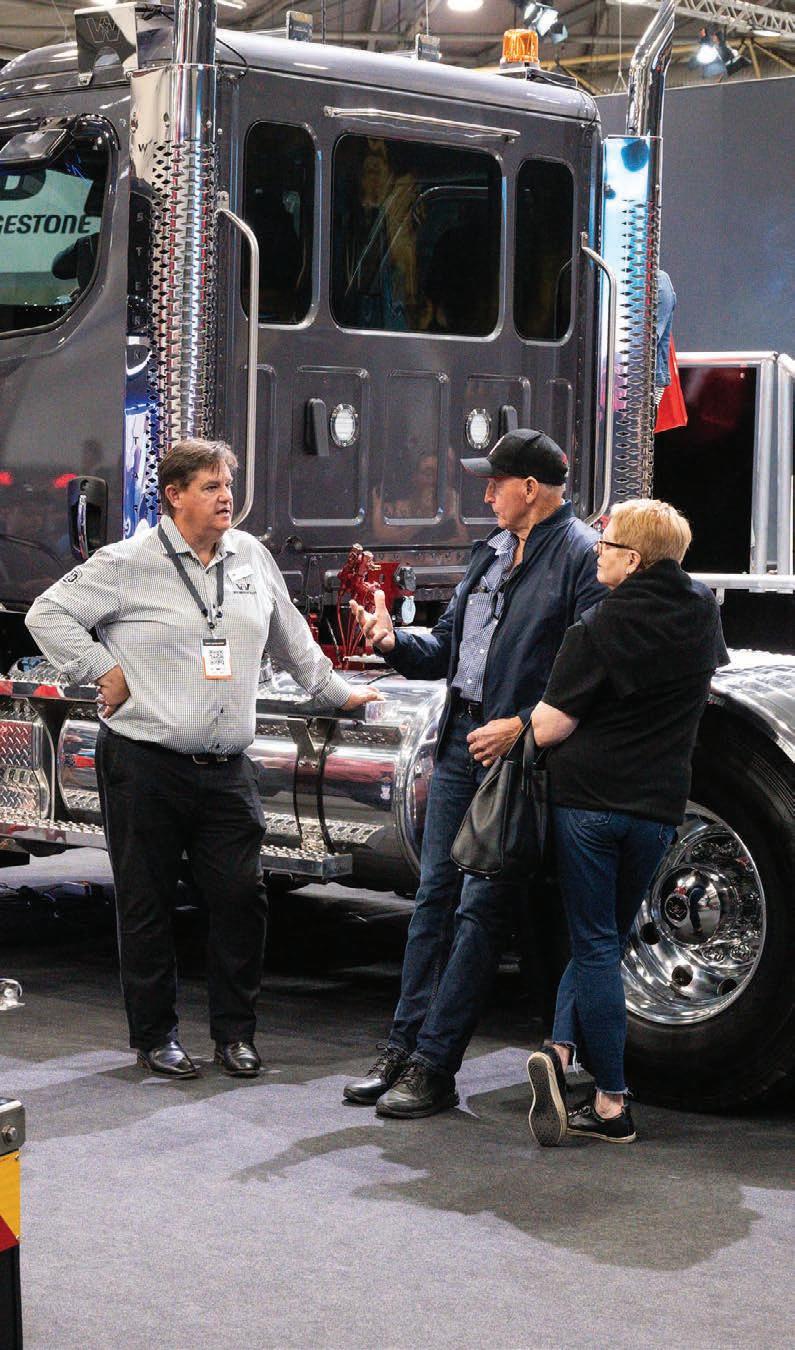
• On the web HVIA and BTS both feature directories for members and exhibitors.
All members are invited to participate in regular:
• Technical meetings. Information sessions.
• Training days.
• High level networking events i.e. The Executive Club.
Positively influence the development and maintenance of policy, legislation, regulation and technical standards, creating an environment that fosters innovation and contributes to the future viability of the heavy vehicle industry, and the safety and productivity of the heavy vehicle fleet.
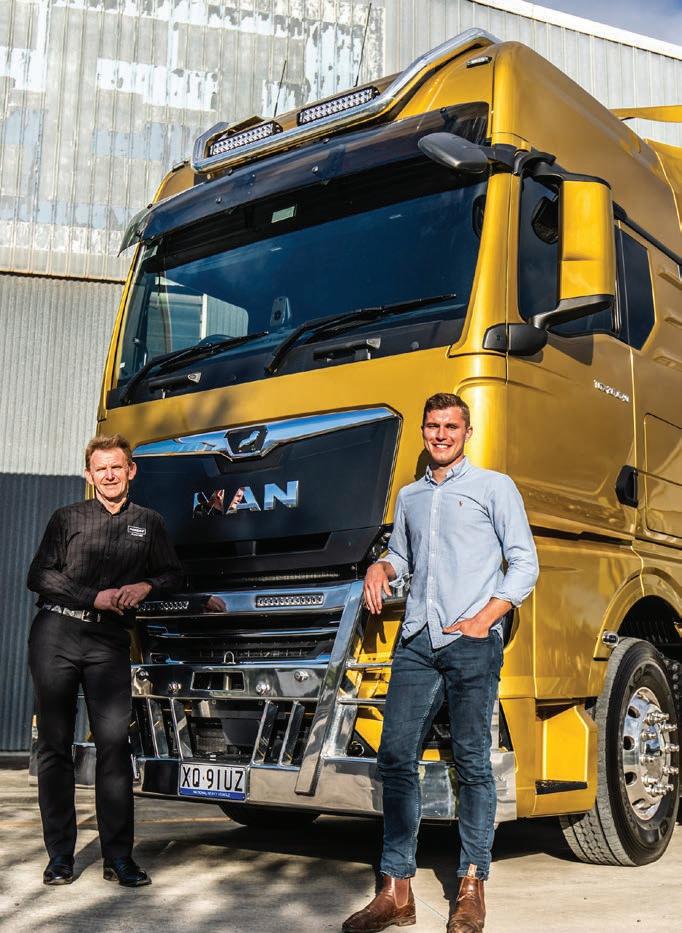


• Solved RVSA implementation issues including improvements to guidance materials, prioritisation of changes to the ROVER system, changes to administrative rules, and expediting urgent or overdue applications.
• Continued to represent industry on the PBS portal digitisation project, including simplifying the administrative burdens of the system.
Shaped the priorities for PBS 2.0 and the Low-Speed Swept Path review, including a comprehensive submission guided by feedback from two industry webinars.
• Hosted industry webinars on the roll-out of the National Class 3 Truck and Dog Notice, and advocated for industry on improvements to ensure the system was fair and workable.
• Advocated for general improvements to access at federal and state levels, focusing on High Productivity Freight Vehicles (HPFVs).
Facilitated member engagement, as subject matter experts, on committees chaired by the Department of Infrastructure to develop and revise ADR and Australian Standards in the fields of next-generation power trains, and mechanical connections (couplings) between vehicle units.
Facilitated industry information sessions to assist in the VSB 6 v3.2 implementation, and advocated for improvements to the J4 code assessment method with the NHVR.
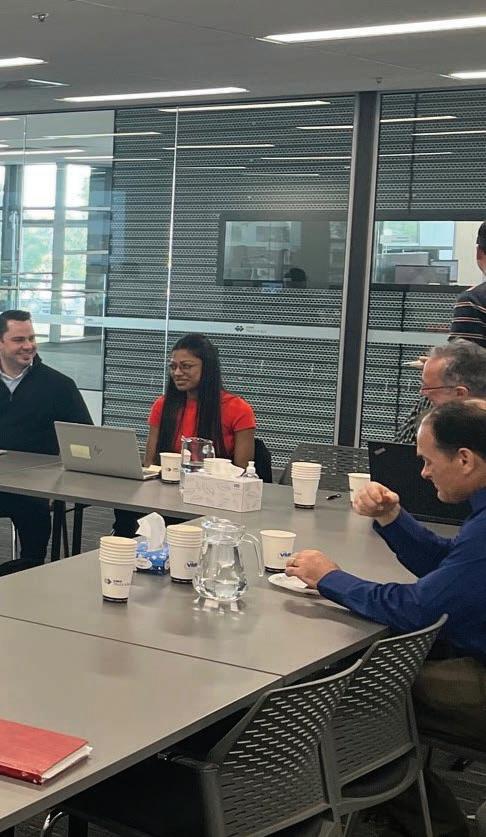
• Participated in the ongoing review of the Heavy Vehicle National Law.
Partnered with Transport Certification Australia and state road authorities to inform industry on changes to telematics for onboard mass compliance, and the closure of the 3G network.

• Partnered with other industry stakeholders to advocate for increased width and axle mass allowances for next-generation zero-emissions heavy vehicles.
• Worked with TAFEs to facilitate relevant training to support the rollout of electric and hydrogen vehicles.
OBJECTIVE
• HVIA welcomed many new Corporate Members, from the length and breadth of the country, ranging from micromembers to national and international institutions. The number of members has exceeded 300 for the first time.
• HVIA membership is for every staff member at every company-owned branch.
HVIA welcomed Wurth Australia and Caltex as new Principal Partners. HVIA’s strong membership base and connection to the heavy vehicle industry were key attractions for Wurth and Caltex.
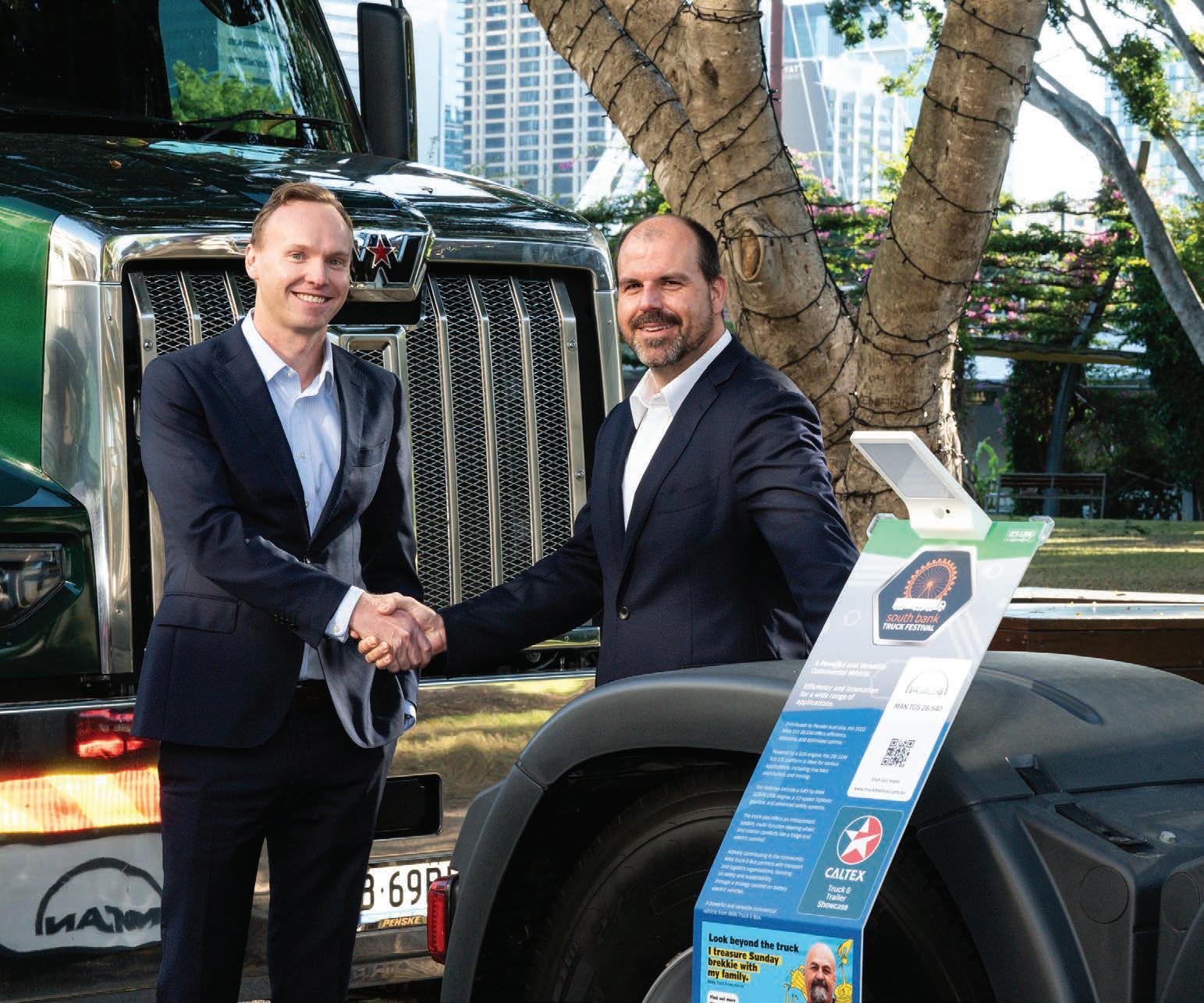
• HVIA Supporting Partners have also grown and now include Ampol, Auto-IT, Chamberlains, EnergyAustralia, Morris, Royans, TransVirtual and Truckline.
• Over 150 member representatives attended the quarterly State Committee Meetings during 2022-2023. HVIA’s regular interactive forums inform HVIA members on current and regulatory issues, industry priorities and opportunities, and are held across Australia in QLD, NSW, VIC and WA.
critical information, support, relationship building, business development and industry best practice.
RoadBoss magazine is an extension of the Brisbane Truck Show’s successful official program which features high-end journalism to promote the best of the trucking industry. RoadBoss is produced by industry for the industry.
Publication of the Brisbane Truck Show official program and new preview magazine was taken in-house. The program directly connects members, messaging with the truck show’s physical audience.
• Truck Chat produced candid face-to-face interviews with the heavy vehicle industry’s key figures, resulting in untapped thoughts from industry’s biggest players. Presented through HVIA’s growing social media channels and Talk the Torque e-newsletter.
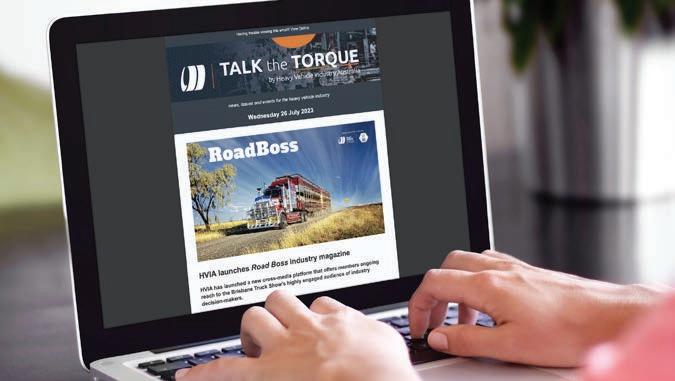

• HVIA utilised its contacts with regulators to assist over 80 members requiring technical and regulatory information saving those members unnecessary hours of research and delays.
Website use up 49%
50,000 users 98,000 page views
Almost 4,000 recipients receive our weekly e-Bulletin
HVIA’s LinkedIn community set to pass 7,000
• Forty members used HVIA’s complementary EmployerAssist member service to gain professional advice on industrial relations and human resource issues including Award interpretation, pay rates, employee management guidance, and workplace health and safety information.
• Almost 4,000 industry and stakeholder recipients now receive HVIA’s weekly Talk the Torque e-newsletter for current news, issues and events updates.
Engagement on HVIA’s website is up 49% to 50,000 users who have viewed over 98,000 pages during 2022/23.
• The continued growth of HVIA’s LinkedIn community is set to pass 7,000 followers this year, now complemented by Brisbane Truck Show and HVIA-LITE project pages.
Secure a highly skilled workforce to ensure the industry’s viability and capacity to deliver innovation.
National Apprentice Challenge
• A new format for the 2023 National Apprentice Challenge saw six training providers from around Australia each selecting two apprentices to compete.

• The two-day event went down to the wire before the Queensland team of Lachlan Tate (Brown and Hurley) and Brayden Conaghan (Penske Australia) took out the title with a flawless fault-finding final.
Much more than just a job campaign
HVIA’s “Much more than just a job” campaign showcases career opportunities in the heavy vehicle industry to school leavers and other job seekers.
• The Brisbane Truck Show careers days brought close to 2,000 students from around 50 schools into South Bank. The National Apprentice Challenge is designed as a showcase of the great career opportunities on offer in the industry, and a variety of industry ambassadors were interviewed by our entertaining and informative host Cobey Bartels.
• The topics covered went beyond the operational side of things, and talked about interacting safely around trucks, with two campaigns being supported by the South Bank Truck Festival: the NHVR’s “Don’t #uck with a truck”, and the National Road Safety Partnership Program’s “Look beyond the truck”.
• A strong contingent of nominations from across the country were received for the 2022 HVIA National Apprentice of the Year Award.
The annual award is open to apprentices in the final stages of their training from the heavy vehicle repair, service and manufacturing sectors, nominated by their employer.
• In 2022 10 finalists were hosted to attend HVIA’s Gala Awards Dinner in Brisbane.
• HVIA’s popular HV101 online induction training course is available to HVIA members, providing staff with a broad understanding of heavy vehicle industry vocabulary and terminology.
• HVIA has launched two new interactive on-line training courses covering best practice procedures for Load Restraint and Tyre Management to improve workplace safety. The development of the courses has been supported by the Australian Government’s Heavy Vehicle Safety Initiative managed by the NHVR.
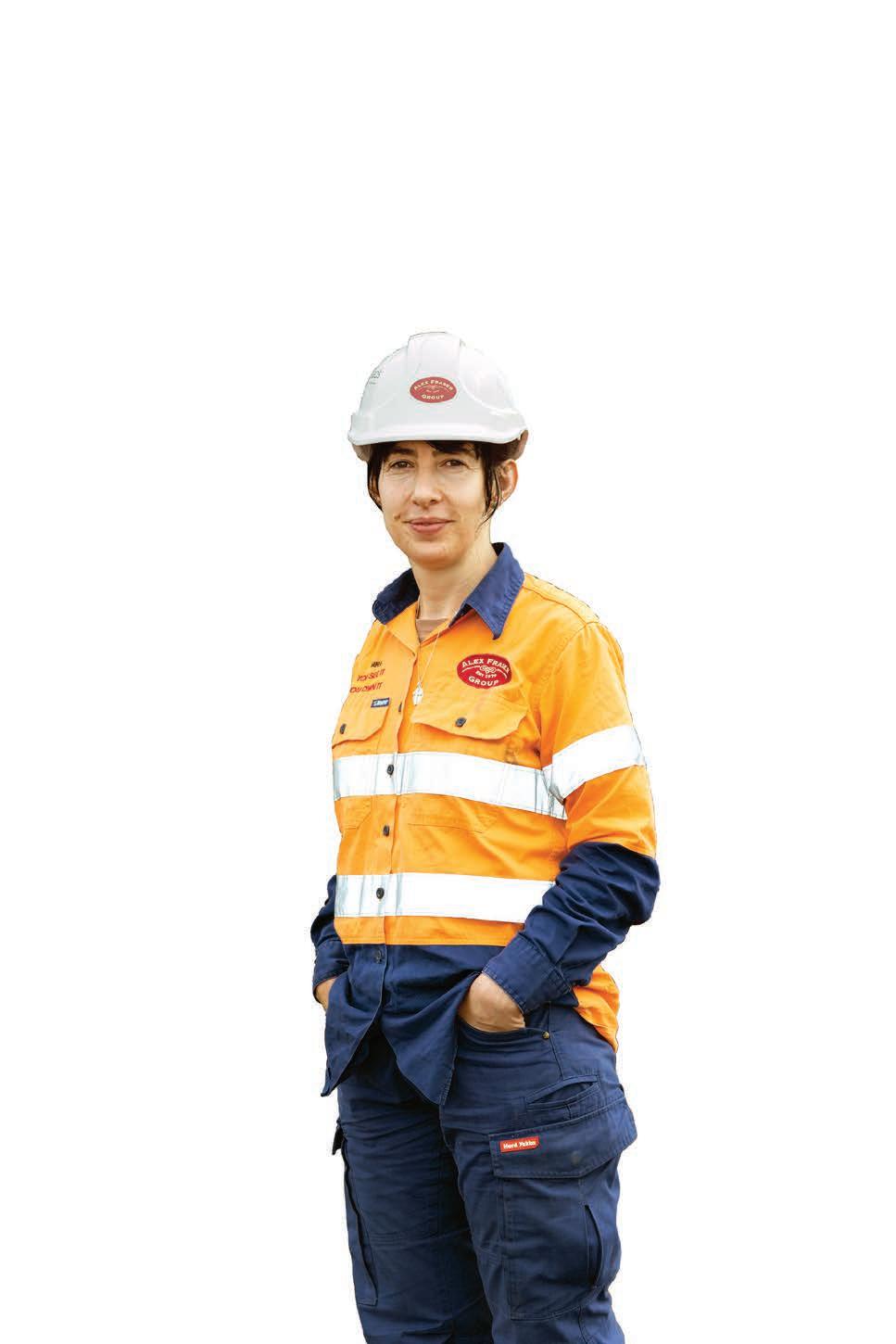
Brisbane Truck Show careers days


2,000 students
50 schools


beyond the truck I love spending time in the country with my kids.
Host world-class events that deliver value, foster innovation, and showcase and promote the latest heavy vehicles and their components, equipment and technology.


HVIA’s prestigious National Awards were presented in front of a full house at a Gala Dinner held at the Emporium South Brisbane during November. The number of guests from

• The Queensland Government and Brisbane City Council (Brisbane Economic Development Agency) have provided support and assistance since AHVIW was launched in 2019.
• Australian Heavy Vehicle Industry Week 2023 included the country’s biggest-ever program of heavy vehicle events and activities and the largest display of zero-emissions vehicles in the Southern Hemisphere.
• In addition to the Brisbane Truck Show, activities also encompassed the South Bank Truck Festival (South Bank Parklands), the Heavy Equipment and Machinery Show (RNA Showgrounds), and the Heritage Truck Show (Rocklea Showgrounds) as well as numerous conferences, dinners, product launches, drive days, factory tours and other events and activations at venues throughout Brisbane.
• The 2023 Brisbane Truck Show saw a record turnout from the heavy vehicle and road freight industries and friends and family from the length and breadth of Australia and further afield.

• Safety Innovation Award – WINNER: Scania Australia, Securing the Future of Workshop Safety.
Community Leadership Award – WINNER: Penske Australia, Outback Futures.
National Apprentice of the Year Award sponsored by Wurth Australia – WINNER: Hunter Tapping, Brown and Hurley.
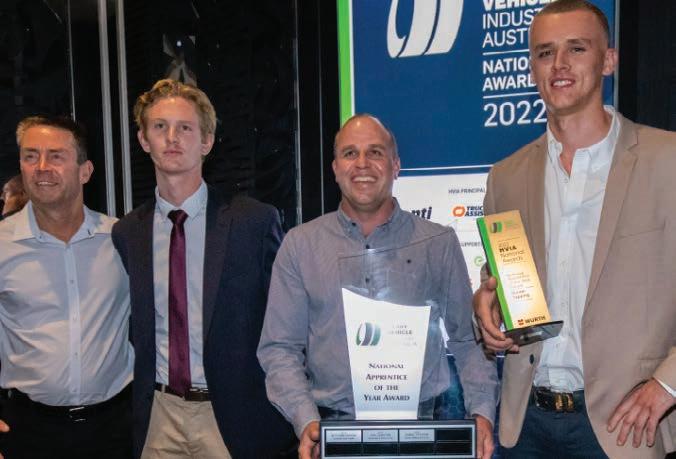
• Peter Langworthy Future Leader Award –WINNER: Thomas Baggaley, CMV Truck & Bus.
• Ken Cowell and Max Winkless were honoured with HVIA Industry Recognition awards, and SGESCO-MAX was presented with an award for 50 years of continuous membership.
• Victorian (Southern Region) members were also able to celebrate their local successes at a special HVIA Executive Club event hosted by EnergyAustralia.
The HVIA Executive Club brought industry leaders together at three well-attended events in Melbourne, Brisbane and alongside the ATA’s Trucking Australia Conference.
• Produced by HVIA (formerly CVIAQ) on behalf of its members since its inception in 1968, the 2023 show has eclipsed all records for attendance with 42,855 through the doors.
• HVIA self-published a Brisbane Truck Show preview magazine in November 2022, with over 12,000 print copies circulated. The 200-page Official Show Program was also published by HVIA.
• A variety of new digital technologies were introduced to offer every exhibitor increased opportunities to connect and engage with attendees.
A BTS23 review magazine is scheduled for publication in October and will see the launch of a new ongoing quarterly industry showcase publication, now connecting more than 40,000 subscribers on an ongoing basis.
• BTS23 social media saw Facebook followers pass 33,000 with over 1.7 million reach across the campaign.
• The BTS website had over 134,000 visitors viewing 400,000 pages.

Your directors presents this report on the company for the financial year ended 30 June 2023.
The names of each person who has been a director during the year to the date of this report are:
John Drake (President)
Miles Crawford (Vice President)
Tony Clark
Ken Cowell
Rod Cunningham
Craig Lee
Robert Smedley
Roy Lombardi
Daniel Whitehead
The directors have been in office since the start of the financial year to the date of this report unless otherwise stated.
John Drake
Associate Diploma in Mechanical Engineering
Rod Cummingham
Graduate Certificate of Management
General Manager Program
- Managing Director, The Drake Group
First elected October 2017
- General Manager
Magnum Australia Pty Ltd
First elected October 2017
Ken Cowell - Director, KD Cowell & Associates
Diploma of Management
Associate Diploma in Mechanical Engineering
Miles Crawford
Bachelor of Mechanical Engineering - Mechanical
Manufacturing Engineering
Bachelor of Business Management – Operations Management
First elected October 2017
Retired 20 October 2022
- General Manager CMV Truck & Bus - Victoria
First elected October 2018
Daniel Whitehead - President & CEO, Daimler Truck and Bus Degree in Accounting & Finance Australia Pty Ltd
First appointed May 2020
Roy Lombardi - CEO, Howard Porter & Steelbro
Bachelor of Business Degree (Major – Marketing and
First appointed May 2020 Management)
Tony Clark - CEO, National Transport Insurance
Master of Advanced Business Practice
Strategic Leadership: The Transformational Process
ANAIIF Fellow
Strategic Marketing – Customer Loyalty
Master of Business Administration
First appointed October 2021
Craig Lee - EGM, On Highway at Penske Australia
Automotive and Master of Business Administration
Engineering Tradesperson
Robert Smedley
Bachelor of Engineering ( Major – Robotics & Mechatronics)
First appointed June 2022
- Managing Director, Smedley’s Engineers Pty Ltd
First appointed June 2022
The accompanying notes form part of these financial statements. Page |
During the financial year, 5 meetings of directors were held. Attendances by each director were as follow:
The entity is incorporated under the Corporations Act 2001 and is a company limited by guarantee. If the entity is wound up, the constitution states that each member is required to contribute a maximum of $20 each towards meeting any outstanding obligations of the entity. At 30 June 2023, the total amount that members of the entity are liable to contribute if the entity is wound up is $20 (2022: $20).
The following person held the position of Company Secretary at the end of the financial year:
Todd Hacking BA. LLB (GDLP)The principal activities of HVIA and its Mission, is to advocate for a successful and sustainable heavy vehicle industry with a strong unified voice It’s Vision is to provide an innovative, prosperous heavy vehicle industry supporting the safest, most productive fleet and HVIA’s purpose is to represent and advance the interests of the entire heavy vehicle industry.
HVIA maintains a Strategic Plan which is monitored and reviewed on a continuous basis at board meetings. The board also holds Strategic Planning session once a year where any major industry developments, issues or risks are identified and, if required integrated into the HVIA Strategic Plan and/or HVIA Risk Management Plan.
HVIA’s short and long term objectives are articulated through its Strategic Plan via four key program areas.
Objective – positively influence the development and maintenance of policy, legislation, regulation and technical standards, creating an environment that fosters innovation and contributes to the future viability of the heavy vehicle industry, and the safety and productivity of the heavy vehicle fleet
Objective – deliver critical information, support, relationship, business development and industry practice.
Objective – secure a highly skilled workforce to ensure the industry’s viability and capacity to deliver innovation. Through participation on the Commonwealth Government Automotive Strategic and Heavy Vehicle Industry Reference Committee, HVIA plays a role in developing policy and the oversight of national training package development.
accompanying notes form part of these financial statements. Page |
Objective – host world class events that deliver value, foster innovation, showcase and promote the latest heavy vehicles and their components, equipment and technology.
HVIA has introduced a digital option to its State Committee meetings to increase engagement with its members, particularly those that are located in regional areas who are unable to attend the in person meetings.
No significant changes in the company's state of affairs occurred during the financial year.
No matters or circumstances have arisen since the end of the financial year which significantly affected or may significantly affect the operations of the company, the results of those operations, or the state of affairs of the company in subsequent financial years.
The company's operations are not regulated by any significant environmental regulation under a law of the Commonwealth or of a State or Territory.
No director has received or has become entitled to receive, during or since the financial year, a benefit because of a contract made by the company or related body corporate with a director, a firm which a director is a member or an enti ty in which a director has a substantial financial interest.
No indemnities have been given or agreed to be given or insurance premiums paid or agreed to be paid, during or since the end of the financial year, to any person who is or has been an officer or auditor of the company.
No person has applied for leave of Court to bring proceedings on behalf of the company or intervene in any proceedings to which the company is a party for the purpose of taking responsibility on behalf of the company for all or any part of those proceedings. The company was not a party to any such proceedings during the year.
A copy of the auditor's independence declaration as required under section 307C of the Corporations Act 2001 has been included.
This directors’ report is signed in accordance with a resolution of the Board:
 John Drake
John Drake
Dated: September 2023
notes form part of these financial statements.
In accordance with Section 307C of the Corporations Act 2001, I am pleased to provide the foll owing declaration of Independence to the directors of Heavy Vehicle Industry Australia. As the lead audit partner for the audit of the financial report of Heavy Vehicle Industry Australia for the year ended 30 June 2023.
I declare that, to the best of my knowledge and belief, during the year ended 30 June 2023 there have been no contraventions of:
(i) the auditor independence requirements of the Corporations Act 2001 in relation to the audit; and
(ii) any applicable code of professional conduct in relation to the audit
Signed Name Name of Firm

Date
Address
Raj Prabhu, Registered Company Auditor
KBP Audit Services 13 September 2023

Suite 1.12, 1 Westlink Court
Darra, Qld 4076
ABN 66 009 819 756
The company does not have ‘public accountability’ as defined in AASB 1053 Application of Tiers of Australian Accounting Standards and is therefore eligible to apply ‘Tier 2” reporting framework under Australian Accounting Standards. Accordingly, the information in these financial statements has been prepared in accordance with the recognition and measurement requirements in Australian Accounting Standards and the disclosure in AASB 1060 Simplified Disclosures for For-Profit and Not-for Profit Tier 2 Entities.
For the purposes of preparing the financial statements, the company is a Not-for-profit entity.
These general-purpose financial statements have been prepared in accordance with the Corporations Act 2001, Australian Accounting Standards and other authoritative pronouncements issued by the Australian Accounting Standards Board (AASB), and comply with other requirements of the law.
The financial statements comply with Australian Accounting Standards, including AASB 1060 Simplified Disclosures for For-Profit and Not-for Profit Tier 2 Entities.
The financial statements have been prepared on the basis of historical cost, except for certain properties and financial instruments that are measured at revalued amounts or fair values at the end of each reporting period, as explained in the exchange for goods and services. All amounts are presented in Australian dollars, unless otherwise noted
Cash and cash equivalents include cash on hand, deposits held at call with banks, other short-term highly liquid investments with original maturities of three months or less, and bank overdrafts. Bank overdrafts are shown within shortterm borrowings in current liabilities on the statement of financial position
The company measures some of its assets at fair value on either a recurring or non-recurring basis, depending on the requirements of the applicable accounting standard. Fair value is the price the company would receive to sell an asset in an orderly (i.e. unforced) transaction between independent, knowledgeable and willing market participants at the measurement date.
As fair value is a market-based measure, the closest equivalent observable market pricing information is used to determine fair value. Adjustments to market values may be made having regard to the characteristics of the specific asset. The fair values of assets that are not traded in an active market are determined using one or more valuation techniques. These valuation techniques maximise, to the extent possible, the use of observable market data.
To the extent possible, market information is extracted from either the principal market for the asset (i.e. the market with the greatest volume and level of activity for the asset) or, in the absence of such a market, the most advantageous market available to the entity at the end of the reporting period (i.e. the market that maximises the receipts from the sale of the asset, after taking into account transaction costs and transport costs).
For non-financial assets, the fair value measurement also takes into account a market participant’s ability to use the asset in its highest and best use or to sell it to another market participant that would use the asset in its highest and best use.
Financial assets and financial liabilities are recognised when the entity becomes a party to the contractual provisions of the instrument. For financial assets, this is equivalent to the date that the company commits itself to either purchase or sell the asset (i.e. trade date accounting is adopted).
ABN 66 009 819 756
For the year ended 30 June 2023
Financial instruments (except for trade receivables) are initially measured at fair value plus transaction costs, except wher e the instrument is classified “at fair value through profit or loss”, in which case tran saction costs are expensed to profit or loss immediately. Where available, quoted prices in an active market are used to determine fair value. In other circumstances, valuation techniques are adopted.
Trade receivables are initially measured at the transac tion price if the trade receivables do not contain a significant financing component or if the practical expedient was applied as specified in paragraph 63 of AASB 15: Revenue from Contracts with Customers.
Classification and subsequent measurement
Financial liabilities
Financial liabilities are subsequently measured at: – amortised cost or
fair value through profit and loss.
A financial liability is measured at fair value through profit and loss if the financial liability is:
a contingent consideration of an acquirer in a business combination to which AASB 3: Business Combinations applies – held for trading or
initially designated as at fair value through profit or loss.
All other financial liabilities are subsequently measured at amortised cost using the effective interest method. The effective interest method is a method of calculating the amortised cost of a debt instrument and of allocating interest expense to profit or loss over the relevant period. The effective in terest rate is the internal rate of return of the financial asset or liability. That is, it is the rate that exactly discounts the estimated future cash flows through the expected life of the instrument to the net carrying amount at initial recognition.
A financial liability is held for trading if it is:
incurred for the purpose of repurchasing or repaying in the near term
part of a portfolio where there is an actual pattern of short -term profit taking or
a derivative financial instrument (except for a derivative that is in a financial guarantee contract or a derivative that is in an effective hedging relationship).
Any gains or losses arising on changes in fair value are recognised in profit or loss to the extent that they are not part of a designated hedging relationship.
The change in fair value of the financial liability attributable to changes in the issuer’s credit risk is taken to other comprehensive income and is not subsequently reclassified to profit or loss. Instead, it is transferred to reta ined earnings upon derecognition of the financial liability.
If taking the change in credit risk to other comprehensive income enlarges or creates an accounting mismatch, these gains or losses should be taken to profit or loss rather than other comprehensi ve income.
A financial liability cannot be reclassified.
Financial assets
Financial assets are subsequently measured at:
amortised cost – fair value through other comprehensive income or – fair value through profit or loss.
Measurement is on the basis of two primary criteria:
the contractual cash flow characteristics of the financial asset and – the business model for managing the financial assets.
ABN
For the year ended 30 June 2023
A financial asset that meets the following conditions is subsequently measured at amortised cost:
the financial asset is managed solely to collect contractual cash flows and
the contractual terms within the financial asset give rise to cash flows that are solely payments of principal and interest on the principal amount outstanding on specified dates .
A financial asset that meets the following conditions is subsequently measured at fair value through other comprehensive income:
the contractual terms within the financial asset give rise to cash flows that are solely payments of principal and interest on the principal amount outstanding on specified dates and
the business model for managing the financial asset comprises both contractual cash flows collection and the selling of the financial asset.
By default, all other financial assets that do not me et the measurement conditions of amortised cost and fair value through other comprehensive income are subsequently measured at fair value through profit or loss.
The company initially designates a financial instrument as measured at fair value through prof it or loss if:
it eliminates or significantly reduces a measurement or recognition inconsistency (often referred to as an “accounting mismatch”) that would otherwise arise from measuring assets or liabilities or recognising the gains and losses on them o n different bases
– it is in accordance with the documented risk management or investment strategy and information about the groupings is documented appropriately, so the performance of the financial liability that is part of a group of financial liabiliti es or financial assets can be managed and evaluated consistently on a fair value basis and
it is a hybrid contract that contains an embedded derivative that significantly modifies the cash flows otherwise required by the contract.
The initial measurement of financial instruments at fair value through profit or loss is a one -time option on initial classification and is irrevocable until the financial asset is derecognised.
At initial recognition, as long as the equity instrument is not held for trading or is not a contingent consideration recognised by an acquirer in a business combination to which AASB 3 applies, the Company makes an irrevocable election to measure any subsequent changes in fair value of the equity instruments in other comprehensive income, while the dividend revenue received on underlying equity instruments investments will still be recognised in profit or loss.
Regular way purchases and sales of financial assets are recognised and derecognised at settlement d ate in accordance with the company’s accounting policy.
Derecognition refers to the removal of a previously recognised financial asset or financial liability from the statement of financial position.
A liability is derecognised when it is extinguished (i.e. when the obligation in the contract is discharged, cancelled or expires). An exchange of an existing financial liability for a new one with substantially modified terms, or a substantial modification to the terms of a financial liability, is treated as an extinguishment of the existing liability and recognition of a new financial liability.
The difference between the carrying amount of the financial liability derecognised and the consider ation paid and payable, including any non-cash assets transferred or liabilities assumed, is recognised in profit or loss.
A financial asset is derecognised when the holder's contractual rights to its cash flows expires, o r the asset is transferred in such a way that all the risks and rewards of ownership are substantially transferred.
All the following criteria need to be satisfied for the derecognition of a financial asset:
For the year ended 30 June 2023
– the right to receive cash flows from the asset has expired or been transferred
all risk and rewards of ownership of the asset have been substantially transferred and
the company no longer controls the asset (i.e. it has no practical ability to make unilateral decisions to sell the asset to a third party).
On derecognition of a financial asset measured at amortised cost, the difference between the asset's carrying amount and the sum of the consideration received and receivable is recognised in profit or loss.
On derecognition of a debt instrument cl assified as fair value through other comprehensive income, the cumulative gain or loss previously accumulated in the investment revaluation reserve is reclassified to profit or loss.
On derecognition of an investment in equity that the company elected to c lassify as at fair value through other comprehensive income, the cumulative gain or loss previously accumulated in the investments revaluation reserve is not reclassified to profit or loss, but is transferred to retained earnings.
The company recognises a loss allowance for expected credit losses on:
financial assets that are measured at amortised cost or fair value through other comprehensive income
– lease receivables
– contract assets (e.g. amount due from customers under contracts)
loan commitments that are not measured at fair value through profit or loss and
financial guarantee contracts that are not measured at fair value through profit or loss.
Loss allowance is not recognised for:
– financial assets measured at fair value through profit or loss or
equity instruments measured at fair value through other comprehensive income.
Expected credit losses are the probability -weighted estimate of credit losses over the expected life of a financial instrument. A credit loss is the difference between all contractual cash flows that are due and all cash flows expected to be received, all discounted at the original effective interest rate of the financial instrument.
The company uses the following approaches to impairment, as applicable under AASB 9: Financial Instruments:
the general approach
the simplified approach – the purchased or originated credit-impaired approach and – low credit risk operational simplification.
Under the general approach, at each reporting period, the company assesses whether the financial instruments are creditimpaired, and:
if the credit risk of the financial instrument has increased significantly since initial recognition, the company measures the loss allowance of the financial instruments at an amount equal to the lifetime expected credit losses and
if there has been no significant increase in credit risk since initial recognition, the company measures the loss allowance for that financial instrument at an amount equal to twelve-month expected credit losses.
The simplified approach does not require tracking of changes in credit risk at every reporting period, but instead requires the recognition of lifetime expected credit loss at all times.
This approach is applicable to:
– trade receivables or contract assets that result from transactions that are within the scope of AASB 15: Revenue from Contracts with Customers, and which do not contain a significant financing component and
lease receivables.
ABN 66 009 819 756
For the year ended 30 June 2023
In measuring the expected credit loss, a provision matrix for trade receivables is used, taking into consideration various data to get to an expected credit loss (i.e. diversity of its customer base, appropriate groupings of its historical loss experience, etc).
For financial assets that are considered to be credit -impaired (not on acquisition or originations), the company measures any change in its lifetime expected credit loss as the difference between the ass et’s gross carrying amount and the present value of estimated future cash flows discounted at the financial asset’s original effective interest rate. Any adjustment is recognised in profit or loss as an impairment gain or loss.
Evidence of credit impairmen t includes:
significant financial difficulty of the issuer or borrower
– a breach of contract (e.g. default or past due event)
– where a lender has granted to the borrower a concession, due to the borrower's financial difficulty, that the lender would not otherwise consider
– the likelihood that the borrower will enter bankruptcy or other financial reorganisation and
the disappearance of an active market for the financial asset because of financial difficulties.
If a financial asset is determined to have low credit risk at the initial reporting date, the company assumes that the credit risk has not increased significantly since initial recognition and, accordingly, it can continue to recognise a loss al lowance of twelve-month expected credit loss.
In order to make such a determination that the financial asset has low credit risk, the company applies its internal credit risk ratings or other methodologies using a globally comparable definition of low cre dit risk.
A financial asset is considered to have low credit risk if:
there is a low risk of default by the borrower
– the borrower has strong capacity to meet its contractual cash flow obligations in the near term and
– adverse changes in economic and business conditions in the longer term, may, but not necessarily, reduce the ability of the borrower to fulfil its contractual cash flow obligations.
A financial asset is not considered to carry low credit risk merely due to existence of collateral, or beca use a borrower has a lower risk of default than the risk inherent in the financial assets, or lower than the credit risk of the jurisdiction in which it operates.
At each reporting date, the company recognises the movement in the loss allowance as an impairment gain or loss in the statement of profit or loss and other comprehensive income.
The carrying amount of financial assets measured at amortised cost includes the loss allowance relating t o that asset. Assets measured at fair value through other comprehensive income are recognised at fair value with changes in fair value recognised in other comprehensive income. The amount in relation to change in credit risk is transferred from other comprehensive income to profit or loss at every reporting period.
For financial assets that are unrecognised (e.g. loan commitments yet to be drawn, financial guarantees), a provision for loss allowance is created in the statement of financial position to recog nise the loss allowance.
At the end of each reporting period, the company assesses whether there is any indication that an asset may be impaired. The assessment will include considering external sources of information and internal sources of information including dividends received from subsidiaries, associates or joint ventures deemed to be out of pre -acquisition profits. If such an indication exists, an impairment test is carried out on the asset by comparing the recoverable amount of the asset, being the higher of the asset’s fair value less costs of disposal and value in use, to the asset’s carrying amount. Any excess of the
ABN 66 009 819 756
For the year ended 30 June 2023
asset’s carrying amount over its recoverable amount is recognised immediately in profit or loss, unless the asset is carried at a revalued amount. Any impairment loss of a revalued asset is treated as a revaluation decrease.
Where it is not possible to estimate the recoverable amount of an individual asset, the company estimates the recoverable amount of the cash-generating unit to which the asset belongs.
Impairment testing is performed annually for intangible assets with indefinite lives.
Revenue is measured based on the consideration to which the company expects to be entitled in a contract with a customer and excludes amounts collected on behalf of third parties. The company recognises revenue when it transfers control of a product or service to a customer.
Rendering of Services
Revenue from a contract to provide services is recognised by reference to the stage of completion of the contract. The stage of completion of the contract is determined by the reference to the total cost of providing the service.
Interest income
Interest income from a financial asset is recognised when it is probable that the economic benefits will flow to the company and the amount of revenue can be measured reliably. Interest income is accrued on a time basis, by reference to the principle outstanding and at the effective interest rate applicable, which is the rate that exactly discounts estimated future cash receipts through the expected life of the financial asset to that asset’s net carrying amount on initial recognition.
Rental income
Rental income from an operating lease is recognised on a straight -line basis over the term of the relevant lease.
Revenues, expenses and assets are recognised net of the amount of GST, except where the amount of GST incu rred is not recoverable from the Australian Taxation Office , it is then recognised as part of the cost of acquisition of an asset or as part of an item of expense
Receivables and payables are stated inclusive of the amount of GST receivable or payable. The net amount of GST recoverable from, or payable to, the ATO is included with other receivables or payables in the statement of financial position.
Cash flows are presented on a gross basis. The GST components of cash flows arising from investin g or financing activities which are recoverable from, or payable to, the ATO are presented as operating cash flows included in receipts from customers or payments to suppliers.
Each class of property, plant and equipmen t are carried at cost or fair value less, where applicable, any accumulated depreciation and impairment losses.
Freehold Property
Freehold land and buildings are carried at their fair value based on periodic, but at least triennial, valuations by external independent valuers, less subsequent depreciation for buildings.
In periods when the freehold land and buildings are not subject to an independent valuation, the directors conduct directors’ valuation to ensure the carrying amount for the land and buildings is not materially different to the fair value . During this financial year an independent valuation was completed by Harley Property Valuations which resulted in an increased fair value
Increases in the carrying amount arising on revaluation of land and buildings are credited to a revaluation surplus in equity. Decreases that offset previous increases of the same asset are charged against fair value reserves directly in equity; all other decreases are charged to the statement of profit and loss and other comprehensive income.
ABN 66 009 819 756
For the year ended 30 June 2023
Any accumulated depreciation at the date of revaluation is eliminated against the gross carrying amount of the asset and the net amount is restated to the revalued amount of the asset.
Plant and equipment are measured on the cost basis and therefore carried at cost less accumulated depreciation and any accumulated impairment. In the event that the carrying amount of plant and equipment is greater than the estimated recoverable amount, the carrying amount is written down immediately to the estimated recoverable amount and impairment losses are recognised either in profit or loss or as a revaluation decrease if the impairment losses relate to a revalued asset. An assessment of recoverable amoun t is made when impairment indicators are present.
The depreciable amount of all fixed assets, including buildings and plant and equipment but excluding freehold land, is depreciated on a straight-line basis over the asset’s useful life to the company commencing from the time the asset is held ready for use. Leasehold improvements are depreciated over the shorter of either the unexpired period of the lease or the estimated useful lives of the improvements.
The depreciation rates used for each cl ass of depreciable asset are:
Class of Fixed Asset
Plant and Equipment
15% -50% Fixtures, fittings and Signages
15% - 25%
5% - 20% Motor Vehicles
The assets' residual values and useful lives are reviewed, and adjusted if appropriate, at the end of each reporting period.
Gains and losses on disposals are determined by comparing proceeds with the carrying amount. These gains or losses are recognised immediately in profit or loss. When revalued assets are sold, amounts includ ed in the revaluation surplus relating to that asset are transferred to retained earnings.
At inception of a contract, the company assesses if the contract contains or is a lease. If there is a lease present, a right -ofuse asset and a corresponding lease liability is recognised by the company where the company is a lessee. However, all contracts that are classified as short-term leases (lease with remaining lease term of 12 months or less) and leases of lowvalue assets are recognised as an operating expense on a straight -line basis over the term of the lease.
Initially, the lease liability is measured at the present value of the lease payments still to be paid at the commencement date. The lease payments are discounted a t the interest rate implicit in the lease. If this rate cannot be readily determined, the company uses the incremental borrowing rate.
Lease payments included in the measurement of the lease liability are as follows: – fixed lease payments less any lease incentives
variable lease payments that depend on an index or rate, initially measured using the index or rate at the commencement date
the amount expected to be payable by the lessee under residual value guarantees
the exercise price of purchase options, if the lessee is reasonably certain to exercise the options
lease payments under extension options if lessee is reasonably certain to exercise the options and – payments of penalties for terminating the lease, if the lease term reflects the e xercise of an option to terminate the lease.
The right-of-use assets comprise the initial measurement of the corresponding lease liability as mentioned above, any lease payments made at or before the commencement date as well as any initial direct costs. T he subsequent measurement of the right-of-use assets is at cost less accumulated depreciation and impairment losses.
ABN
Right-of-use assets are depreciated over the lease term or useful life of the underlying asset whichever is the shortest. Where a lease transfers ownership of the underlying asset or the cost of the right -of-use asset reflects that the company anticipates to exercise a purchase option, the specific asset is depreciated over the useful life of the underlying asset.
Short-term employee benefits
Provision is made for the company’s obligation for short -term employee benefits. Short-term employee benefits are benefits (other than termination benefits) that are expected to be settled wholly before 12 months after the end of the annual reporting period in which the employees render the related service, including wages, salaries and sick leave. Shortterm employee benefits are measured at the (undiscounted) amounts expected to be paid when the obligation is settled.
The company’s obligations for short-term employee benefits such as wages, salaries and sick leave are recognised as part of current trade and other payables in the statement of financial position.
Other long-term employee benefits
Provision is made for employees’ lon g service leave and annual leave entitlements not expected to be settled wholly within 12 months after the end of the annual reporting period in which the employees render the related service. Other long -term employee benefits are measured at the present v alue of the expected future payments to be made to employees. Expected future payments incorporate anticipated future wage and salary levels, durations of service and employee departures and are discounted at rates determined by reference to market yields at the end of the reporting period on government bonds that have maturity dates that approximate the terms of the obligations. Upon the remeasurement of obligations for other long-term employee benefits, the net change in the obligation is recognised in pr ofit or loss as part of employee benefits expense.
The company’s obligations for long -term employee benefits are presented as non -current provisions in its statement of financial position, except where the company does not have an unconditional right to de fer settlement for at least 12 months after the end of the reporting period, in which case the obligations are presented as current provisions.
Trade and other payables represent the liability outstanding at the end of the r eporting period for goods and services received by the company that remain unpaid at the end of the reporting period. The balance is recognised as a current liability with the amounts normally paid within 30 days of recognition of the liability.
No provision for income tax has been raised as the entity is exempt from income tax under Div 50 of the Income Tax Assessment Act 1997.
Software
Software is initially recognised at cost. It has a finite life and is carried at cost less any accumulated amortisation and impairment losses.
Provisions are recognised when the entity has a legal or constructive obligation, as a result of past events, for which it is probable that an outflow of economic benefits will result and that outflow can be reliably measured. Provisions recognised represent the best estimate of the amounts required to settle the obligation at the end of reporting period.
When required by Accounting Standards, comparative figures have been adjusted to conform to changes in presentation for the current financial year.
ABN
The director evaluates estimates and judgements incorporated into the financial statements based on historical knowledge and best available current information. Estimates assume a reasonable expectation of future events and are based on current trends and economic data, obtained both externally and within the company.
The freehold land and buildings were independently valued at 13 September 2022 by Harley Property Valuations. The valuation was based on the fair value less cost to sell. The critical assumptions adopted in determining the valuation included the location of the land and buildings, the current strong demand for land and buildings in the area and recent sales data for similar properties. The valuation resulted in a revaluation increment of $655,999 being recognised in the asset revaluation reserve (Note 2).
As described in Note 1, the company reviews the estimated useful lives of property, plant and equipment at the end of each annual reporting period.
To identify a performance obligation under AASB 15, the promise must be sufficiently specific to be able to determine when the obligation is satisfied. Management exercises judgement to determine whether the promise is sufficiently specific by taking into account any conditions specified in the arrangement, explicit or implicit, regarding the promised goods or services. In making this assessment, management includes the nature/type, cost/value, quantity and the period of transfer related to the goods or services promised.
The lease term is defined as the non-cancellable period of a lease together with both periods covered by an option to extend the lease in the lessee is reasonably certain not to exercise that option. The options that are reasonably going to be exercised is a key management judgement that the entity will make. The entity determines the likeliness to exercise the options on a lease-by-lease basis looking at various factors such as which assets are strategic and which are key to future strategy of the entity.
For the purpose of measurement, AASB 119: Employee Benefits defines obligations for short-term employee benefits as obligations expected to be settled wholly before 12 months after the end of the annual reporting period in which the employees render related service. As the entity expects that most employees will not use all of their annual leave entitlements in the same year in which they are earned or during the 12-month period that follows (despite an informal internal policy that requires annual leave to be used within 18 months), the directors believe that obligations for annual leave entitlements satisfy the definition of other long-term employee benefits and, therefore, are required to be measured at the present value of the expected future payments to be made to employees.
The entity is dependent on its bi-annual Brisbane Truck Show for the majority of its revenue but membership is also a substantial part of its revenue used to operate the business. At the date of this report the Board of Directors has no reason to believe the members will not continue to support the entity.
ABN 66 009 819 756
For the year ended 30 June 2023
Managed Fund Distributions
Income (distributions and linked Cash management account interest) from managed funds for the year was $88,081 compared to $226,568 in 2022.
The entity maintains a portfolio of securities with a current carrying value $3,849,425 at the end of the reporting period. The market value of the Indexed Australian Share Funds is quoted from the Fund Distribution Statement of the fund manager as at 30 June 2023. The total market value of all the funds held at 30 June 2022 was $3,360,055. The market value at 30 June 2023 has increased in value by $202,730 to $3,562,785. There were additional buy of units at a cost of $210,501 during the reporting period
The directors are not aware of any significant events since the end of the reporting period.
The entity’s financial instruments consist of deposits with banks, local money market instruments, short-term and longterm investments, accounts receivable and payable, and lease liabilities.
The totals for each category of financial instruments, measured in accordance with AASB 9, Financial instruments as detailed in the accounting policies to these financial statements, are as follows:

We have audited the financial report of Heavy Vehicle Industry Australia (the Company), which comprises the Statement of Financial Position as at 30 June 2023, the Statement of Comprehensive Income, the Statement of Changes In Equity and the Statement of Cash Flows for the year then ended, and notes to the financial statements, including a summary of significant accounting policies, and the Director's Declaration.
In our opinion, the accompanying financial report of Heavy Vehicle Industry Australia is in ac cordance with the Corporations Act 2001, including:
(a)giving a true and fair view of the company’s financial position as at 30 June 2023 and of its performance for the year then ended; and
(b)complying with Australian Accounting Standards to the extent described in Note 1, and the Corporations Regulations 2001.

We conducted our audit in accordance with Australian Auditing Standards. Our responsibilities under those standards are further described in the Auditor’s Responsibilities for th e Audit of the Financial Report section of our report. We are independent of the company in accordance with the auditor independence requirements of the Corporations Act 2001 and the ethical requirements of the Accounting Professional and Ethical Standards Board’s APES 110 Code of Ethics for Professional Accountants (the Code) that are relevant to our audit of the financial report in Australia. We have also fulfill ed our other ethical responsibilities in accordance with the Code.
We confirm that the independence declaration required by the Corporations Act 2001, which has been given to the director of the company, would be in the same terms if given to the director as at the time of this auditor’s report.
We believe that the audit evidence we have obtained i s sufficient and appropriate to provide a basis for our opinion.
We draw attention to Note 1 to the financial report, which describes the basis of accounting. The financial report has been prepared for the purpose o f fulfilling the director's financial reporting responsibilities under the Corporations Act 2001. As a result, the financial report may not be suitable for another purpose. Our opinion is not modified in respect of this matter
The director is responsible for the other information. The other information comprises the information included in the Company’s annual report for the year ended 30 June 20 23, but does not include the financial report and our auditor’s report thereon.
Our opinion on the financial report does not cover the other information and accordingly we do not express any form of assurance conclusion thereon.
In connection with our audit of the financial report, our responsi bility is to read the other information and, in doing so, consider whether the other information is materially inconsistent with the financial report or our knowledge obtained in the audit or otherwise appears to be materially misstated.
If, based on the work we have performed, we conclude that there is a material misstatement of this other information, we are required to report that fact. We have nothing to report in this regard.
The director of the company is responsible for the preparation of the financial report that gives a true and fair view and has determined that the basis of preparation described in Note 1 to the financial report is appropriate to meet the requirements of the Corporations Act 2001 and is appropriate to meet the needs of the members. The director's responsibility also includes such internal control as the director determines is necessary to enable the preparation of a financial report that gives a true and fair view and is free from material misstatement, whether due to fraud or error.
In preparing the financial report, the director is responsible for assessing the company’s ability to continue as a going concern, disclosing, as applicable, matters relating to going concern and using the going concern basis of accounting unless the director either intends to liquidate the company or to cease operations, or has no realistic alternative but to do so.
Our objectives are to obtain reasonable assurance about whether the financial report as a whole is free from material misstatement, whether due to fraud or error, and to issue an auditor’s report that includes our opinion. Reasonable assurance is a high level of assurance, but is not a guarantee that an audit conducted in accordance with the Australian Auditing Standards will always detect a material misstatement when it exists. Misstatements can arise from fraud or error and are considered material if, individually or in t he aggregate, they could reasonably be expected to influence the economic decisions of users taken on the basis of this financial report.
As part of an audit in accordance with the Australian Auditing Standards, we exercise professional judgment and mainta in professional scepticism throughout the audit. We also:
- Identify and assess the risks of material misstatement of the financial report, whether due to fraud or error, design and perform audit procedures responsive to those risks, and obtain audit evide nce that is sufficient and appropriate to provide a basis for our opinion. The risk of not detecting a material misstatement resulting from fraud is higher than for one resulting from error, as fraud may involve collusion, forgery, intentional omissions, m isrepresentations, or the override of internal control.
- Obtain an understanding of internal control relevant to the audit in order to design audit procedures that are appropriate in the circumstances, but not for the purpose of expressing an opinion on t he effectiveness of the company’s internal control.
- Evaluate the appropriateness of accounting policies used and the reasonableness of accounting estimates and related disclosures made by the director.
- Conclude on the appropriateness of the director's use of the going concern basis of accounting and, based on the audit evidence obtained, whether a material uncertainty exists related to events or conditions that may cast significant doubt on the company’s ability to continue as a going concern. If we con clude that a material uncertainty exists, we are required to draw attention in our auditor’s report to the related disclosures in the financial report or, if such disclosures are inadequate, to modify our opinion. Our conclusions are based on the audit evi dence obtained up to the date of our auditor’s report. However, future events or conditions may cause the company to cease to continue as a going concern.
- Evaluate the overall presentation, structure and content of the financial report, including the disclosures, and whether the financial report represents the underlying transactions and events in a manner that achieves fair presentation.
We communicate with the director regarding, among other matters, the planned scope and timing of the audit and significant audit findings, including any significant deficiencies in internal control that we identify during our audit.
Raj PrabhuKBP Audit Services Suite 1.12

1 Westlink Court, Darra QLD 4076
Signed on 13 September 2023

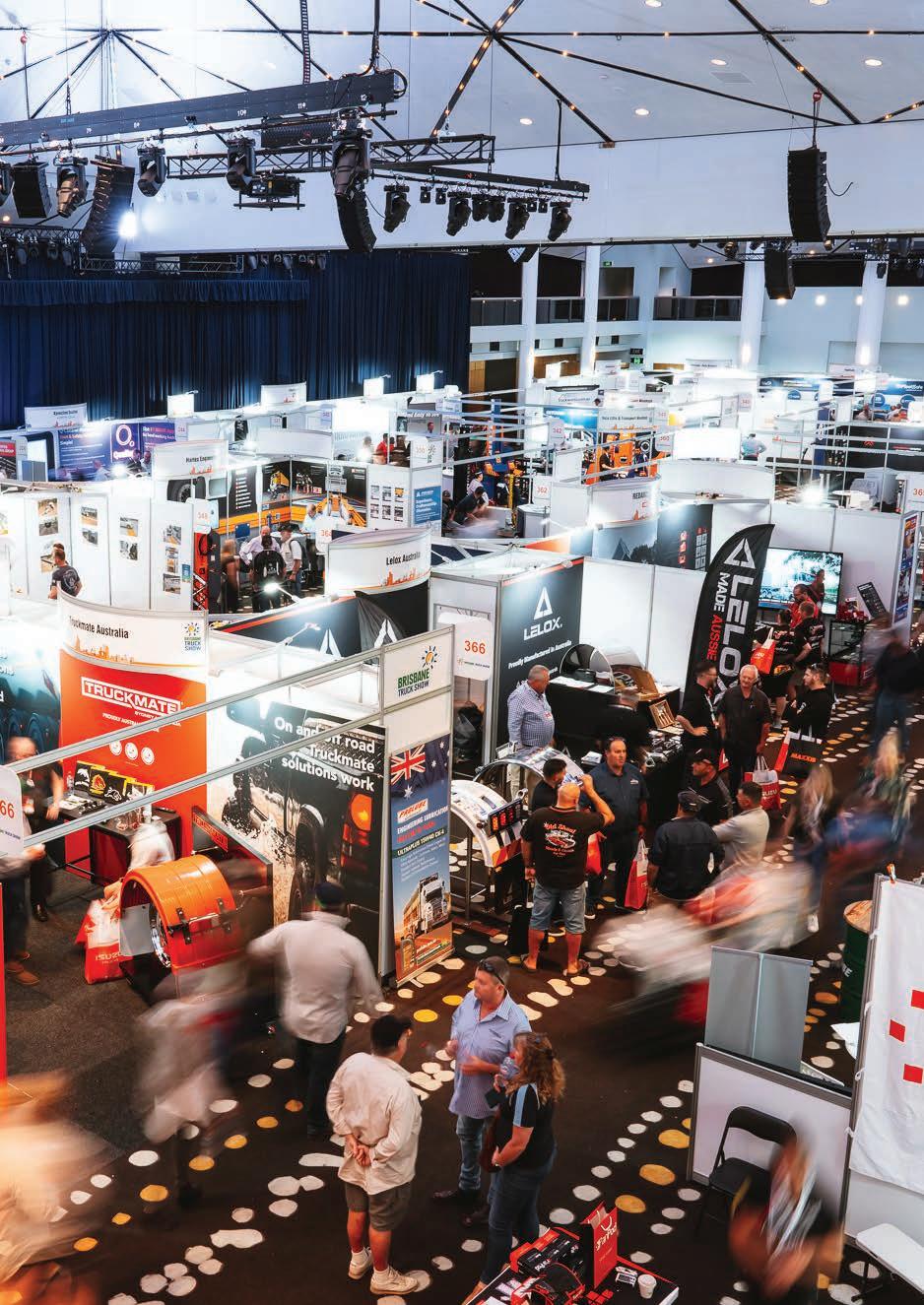
ABS Trailquip
Action Auto Electrics
Action Mechanical Specialists
Active Fleet
Advanced Braking Technology
Advantia Transport Consulting
Aerox
AH Peters
Air & Gas Industries
Air Brake Corporation of Australia
Air Brake Systems
AIR CTI
Air Tarps Australia
Airbag Man
Airtec Corporation
Alemlube
All Vehicle Compliancing
Allison Transmission Japan Co
Allotrac Services
Ampol
Apprenticeships Are Us
Apprenticeships Queensland
Armoury Group
ASET Services
ATB Engineering
Atlantic Oil
Australian Timken - Queensland
Australian Trailer Manufacturers
Australian Trailer Solutions Group
Australian Truck & Trailer Parts
Australian Tyre Traders
Auto.I.T
Autoequip Australia
Automotive Sales Group
AV Truck Services
Avantgarde Distribution
BBallarat Isuzu
Barker Trailers
Barry Stoodley
Base Air Global
Bearing Thermal Resources
BLK Auto
Bluescope Distribution (Orrcon Steel)
Borcat Trailers
BPW Transpec
Bridgestone Australia
Brimarco
Brisbane Isuzu
Briskair
Brown & Watson International
Bruce Rock Engineering
Bucher Municipal
Bulk Transport Equipment
BWFC (ATF BW Consortium Trust)
Byford Equipment
Byrne Trailers
Cablecraft Australia
Caltex
Capral Aluminium
Carey Industrial
Carmate Electronics
Carrier Transicold Australia
Chamberlains
Chamonix (Aust)
Chiefs Australia
Chris’s Body Builders
CIMC Vehicle Australia
Cincom Systems of Australia
Clark Equipment Sales - VIC
Clear21
CMV Group
Commercial Vehicle Compliance
Complete Steering Australia
Consolidated Tyre Company
Convair Engineering
Cooler
Corghi Australia
CraneCo Holdings
Cummins South Pacific
CustomAir Automotive Air Conditioning
DD’Angelo Engineering
Daimler Truck and Bus Australia Pacific
Dana Australia
Daysworth International
DGL AUSblue
Dhollandia Australia
Diesel Services Queensland
Directed Technologies
Dometic Australia
Drake Trailers
DrivaLink
E-Max (Aust)
E-T-A Electro Technical Applications
Eagle SMF Distributors
Easy to Use
Eaton Vehicle Group
ECB
EcoBlue International
Ekebol
Energy Australia
Eurocold
EV Automotive
Evolving Workshop Technologies
EVUp F
Felco Manufacturing
Fibreglass Transport Equipment
Fine Ground
Fleetsafe
Fleetseer
FMP Group (Australia)
Foton Mobility
FUWA K Hitch (Australia)
Garage Equipment
GE & DA Kennedy
Genesis Equipment
Geotab
Get A Grip Tyres
GFR Industries
GMT Tools Technic Australia
Goodyear & Dunlop Tyres (Aust)
Gough Transport Solutions - Queensland
GPC Asia Pacific
Graham Lusty Trailers
Gulf Western Oil
Karmot
KD Cowell & Associates
Keith Walking Floor Australia
Kenndel
Kindred Equipment Sales & Hire
Knorr-Bremse Australia - Queensland
KOR Equipment Solutions
Krueger - Manufacturing Victoria
Kumar Motors (Bankstown)
N
National Automotive Equipment Services
National Transport Insurance
New Age Concepts
NewVolt
Nixons Engineering
Norco Co-Operative
North East Engineering
Nye Holdings (ATFT Nye Family Trust)
Offroad Trucks Australia
HHace Industries
Hammar Australia
Haulmark Trailers (Australia)
Haultech Engineering
Hella Australia
Hendrickson Asia Pacific
Hercules (Qld)
Hino Motor Sales Australia
Hiringa Energy
Hitch Engineering Services
Holmwood Highgate (Aust)
Howmet Wheel Systems Australia
Hubfleet
HV compliance
Hydreco Hydraulics
Hyva Pacific
Hyzon Motors Australia
IIamadillo (T/A PT Blueboys)
Invision Sales
Irons Diesel Services
Isri Seats
Isuzu Australia
Iveco Trucks Australia
LLaws Of Motion
Lelox Australia
Lionel Moore Trailers
Loadmass (T/A Loadman Australia)
Logmaster
Lombardi Nominees
LSM Technologies
Lucidity Australia
MMacNaught
Magnum Australia
MAHA Australia
Mavin Truck Centre
McKenzies Qld
Mega Pacific
Meikawheel Australia
Meritor Heavy Vehicle Systems Australia
Michelin Australia
Mitsubishi Electric Australia
Mobicon Systems
Modern Transport Engineers Australia
Moore Truck Parts
Morris
MOTUM Simulation
Mov3ment
MT Data
Multispares
Muscat Trailers
Omni Tanker
Optix Australasia
PPACCAR Australia
Parish Engineering Company
Patra Truck Bodies
Paulger Engineering
Penske Commercial Vehicles
Powerdown Australia
Precision Automotive Equipment
Prochem Haulage
Procon MRM Transport
Pure Hydrogen Corporation
QQMW Industries
QTRS
Queensland Rail
Queensland Thermo King
J Thompson & Associates
Jost Australia
R&J Batteries
Razor International
Redcat Group
Retractable Tarps
Rhino Guards
Rhino Trailers
Roadpod
Robotic Automation
Robuk Engineering
Rocklea Truck Electrical
Rogers Axle and Spring Works
Ron Finemore Transport Services
ROPS Engineering Australia
Royans
Russ Engineering
Rytrans
600 Cranes Australasia
SAF-Holland (Aust)
Samios Wholesale Tyres
Sampa Australia
Scania Australia - Queensland
Schmitz Cargobull
Scully Sales
SEA Electric
Sensium
Shephard Transport Equipment
Significant Holdings (ATFT Raanan Investment)
Smedley’s Engineers - NSW
Smith Global
South East Queensland Tilt Tray
Speedywash Australia
Spitwater Qld
Starter & Generator Exchange Service
Starworx
Stemco
Stenhoj
Strategic Fleet Management
Suburban Towing & Equipment
T3M Australia
Taro Distributors
Techtronic Industries Australia (Milwaukee Tools)
Tefco Trailers (Qld)
Tele Radio Australia
Teletrac Navman
The Brown & Hurley Group
The Strasburgs Livestock & Trailers
Tidal Fluid Power
Tiger Spider
TMC Australia
Tosca Industries
TotalEnergies Marketing Australia
TR Group
Trail-Link
Trailer Sales
Tramanco
Transport Engineering and Management
Transport Equipment Australia
Transport Refrigeration Service
TransVirtual
Tranzmile
Triple M Holdings
Tristar Industries
TRT (Aust)
Truck Art Trailers
Truck Engineering Australia
Truck Hydraulic Solutions - NSW
TruckAssist
Truckline
Truckmate (Australia)
Trucks On The Run
Trucktools
Tucker Suspension Services
Tuff Trailers (Qld)
Tyres4U
Tyretrak
Ultimate Plant Trailers
VV-DAQ
Vacuum Truck Supplies
Vacvator
Valvoline
Varley Specialised Vehicles - Qld
Vawdrey Australia
Volvo Group Australia
WWalsh Engineering Solutions
Warby Tools Australia
Western Truck Group
West-trans Equipment and Service
Westrans Consultancy
Westrans Services WA
WHG - Technologies
Workshop Solutions
Wurth
YHI Power
ZF Services Australia
Zylux Distribution
as at 12th September 2023
Mr Steven Abrahamson
Mr Christopher Bleakly
Mr Barry Bonnitcha
Mr Bert Boock
Mr Rob Brown
Mr Val Burns (Dec’d)
Mr Malcom Chisholm (Dec’d)
Mr Allyn Eckford (Dec’d)
Mr Mark Johnston
Mr Mike Langham
Mr Bob Martin
Mr Jack McKenna (Dec’d)
Mr Des Mitchell (Dec’d)
Mr John Morgan
Mr Earle Russ (Dec’d)
Mr Les Singleton
Mr Robert Slack (Dec’d)
Mr Ray Smithers
Mr Max Steele (Dec’d)
Mr Ted Van Fleet (Dec’d)
as at 12th September 2023
 Mr Joseph Carmody (Dec’d)
Mr Joseph Carmody (Dec’d)
